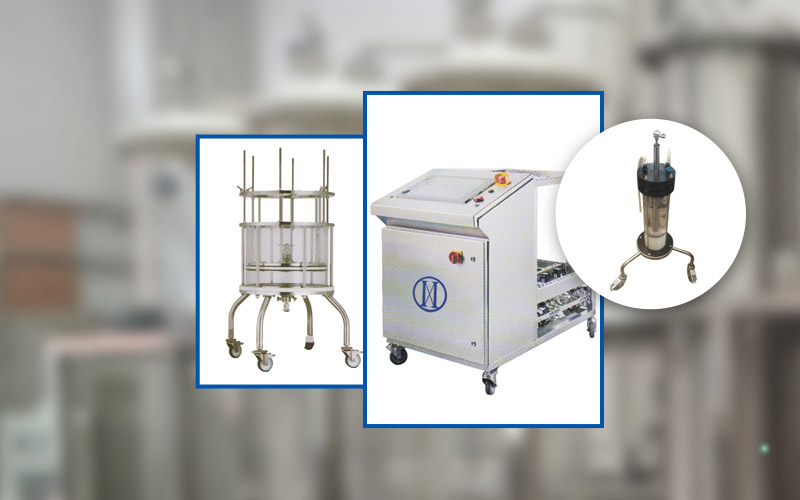News
The new trend of development of chromatography in the field of biological pharmacy
Company news
2018/08/20 09:23
[Abstract]:
Editor: in recent years, column chromatography has made many innovations, especially in the areas of automation and process control. New precision controllers for fluid transmission and data acquisition and advanced processing systems improve the reliability and reproducibility of column chromatography. China pharmaceutical machinery network reports.
Tomography is one of the most powerful purification tools and is widely used in many industries. In particular, in the biopharmaceutical industry, improved tomographic techniques are helping manufacturers cope with emerging capacity challenges. In recent years, in order to meet the growing demand for non-impurity proteins, viruses, nucleic acids, enzymes and enzyme inhibitors, manufacturers have been increasing the application of chromatography technology in drug purification. With the increase of application, many new trends have emerged in chromatography technology.
Personalized custom chromatography
Currently, there are a number of therapies based on recombinant cells from different sources, including mammalian and non-mammalian cells, genetically modified milk, and maize and tobacco plants. The variety of raw materials requires the individualization of the chromatography process to achieve the highest efficiency. In some cases, the drug purification process may contain up to six independent tomographic steps. Fortunately, tomographic engineering can help manufacturers tailor solutions to specific applications.
For manufacturers of recombinant therapeutic drugs, column chromatography is the most commonly used and powerful purification method in the downstream production process, and can be used in a variety of methods including affinity, ion exchange, hydrophobic effect, metal chelation and gel filtration. Increasing production to meet demand at a faster pace has put pressure on manufacturers as the number of drugs required for high doses and long-term regulation increases. The capacity increase is achieved by expanding the column chromatography equipment, the maximum column used in production is more than two meters in diameter, and larger column may be required in some production equipment.
Auto loading of column
In recent years, the column chromatography method has made many innovations, especially in the fields of automation and process control. New precision controllers for fluid transmission and data acquisition and advanced processing systems improve the reliability and reproducibility of column chromatography.
One area where automation promotes the scientific development of column chromatography is the loading process. Loading the medium into the column was once regarded as a production activity requiring skilled skills and labor intensity, and required a lot of operation training to ensure consistency. However, in fact, even the most skilled manual operation can lead to uncertainty and may damage the repeatability of the batch. Reproducibility is critical to drug development, and product purity and yield are affected if column loading is not up to par. The most serious result is that the production of the lot will be disrupted, leading to significant cost overruns and production stoppages.
The innovative breakthrough of tomographic column loading lies in the adoption of automatic in-situ loading technology, that is, in the loading process, through the independent loading station, resuspended medium and pumped into the assembled column. In-situ loading is conducive to uniform loading of media into the column, resulting in better resolution and yield. It also ensures a more stable filling bed, thus increasing consistency between batches.
Another advantage of automatic in-situ loading is that it makes the whole process more sanitary because the operator USES a fully enclosed system. All loading and in-place cleaning processes do not require the removal of the column head, eliminate the risk of contamination in the production process and, in some cases, prevent the operator from being harmed in the handling of biological hazardous materials. At present, more than 70% of the new column chromatography equipment use in - situ loading system.
One of the most important developments in column chromatography is the use of ultrasonic technology to monitor the density of column packed bed. Although still in the development stage, the application of ultrasonic assisted tomographic column loading will be commercialized sooner or later. Its performance directly determines its great potential and provides an accurate tool for the operator to judge the loading of the column.
Ultrasonic detector is very sensitive to column bed compression, flow composition and soluble composition in tomographic column. The ultrasonic wave can detect the "real time" component data recorded and verified before the tomographic column is used, and the dynamic feedback control from the loading station can help ensure the consistency and accuracy of loading before use.
The advantages of membrane chromatography are obvious
In many applications, membrane chromatography shows significant advantages in speed and process economy. The technique USES a porous membrane and bonds reactive chemical groups on the surface of the membrane. Membrane chromatography has a porous structure which can be chemically modified by bonded charged hydrophilic polymers. Open pore structure provides more usable surface area for biomolecular binding than conventional tomographic packing. Convection orifices facilitate rapid and efficient material transfer because fluid flows directly through the membrane orifices without diffusion flow restrictions.
At present, membrane chromatography has been successfully applied in the capture and removal of DNA, proteins and viruses in the production scale. The rate of removing impurities is 100 times higher than that of column chromatography. The surface area that can be combined in column chromatography is mostly in packed hole structure, which can only be achieved by diffusion. Macromolecules and viruses do not diffuse into these pores and bind only to sites on the outer surface of the filler. Compared with column chromatography, membrane chromatography without diffusion flow restriction is 10~100 times higher in removing DNA, virus and plasmid. Membrane chromatography can also be linearly amplified, which is a key factor that manufacturers need to consider to expand the product from the laboratory scale to the production scale.
Membrane chromatography is more effective than column chromatography in capturing large molecules, which is particularly advantageous in mass production where small plasmid DNA or viruses need to be captured. Membrane chromatography is increasingly regarded as a feasible technology in the purification of gene therapy vectors. The positively charged Q film can effectively bind plasmid DNA with a size of 23kb, while the rapid process of membrane chromatography can effectively separate unstable macromolecular plasmids.
Membrane chromatography can effectively remove model viruses, such as porcine parvovirus, hepatitis a virus, mouse leukemia virus and pseudorabies virus, with removal efficiency of 104 and 107.
In the representative cases, membrane chromatography has been successfully implemented as a later stage of purification. The us food and drug administration (FDA) and the European commission on drugs (EMEA) have approved the use of membrane chromatography to purify Aldurazyme, an enzyme replacement treatment produced by BioMarin, an American biopharmaceutical company.
When used in conjunction with membrane-based molecular exclusion ultrafiltration, membrane chromatography provides an orthogonal method of virus removal as required by FDA and EMEA. This allows BioMarin to be free of DNA batching, a milestone in the production of protein drugs. Besides saving an average of $2,000 per batch, BioMarin has greatly reduced the probability of failure in production batches, and the cost of failure is extremely high. By widely adopting similar processes, biopharmaceutical companies can save tens of millions of dollars in the production of monoclonal antibodies and recombinant protein drugs.
Membrane chromatography may be discarded or reused. Their application is very flexible and can often be added to existing production processes as a refinement step. Because membrane chromatography can be used once, there is no cleaning or cleaning inspection problem, which greatly speeds up production and reduces labor and buffer costs.

